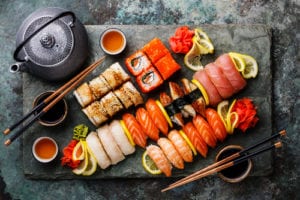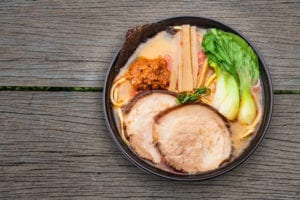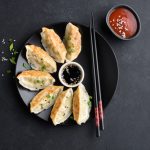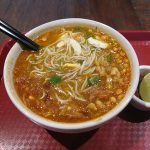
A quick guide to the staples of Japanese cuisine
‘’I think I’m turning Japanese’’ was the unforgettable song title of ‘The Vapors’ fun smash hit of 1980. And, it might not be such a bad idea when it comes to eating out. If you have never tried Japanese cuisine, then you might find it a surprising pleasant change to your usual dining-out experience. Not only that, Japanese food is, for the most part, highly nutritious and healthy.
Sushi
For most of us, I would guess ‘sushi’ is probably the first thing that comes to mind with the mention of Japanese food. Sushi is raw fish, isn’t it? For many years, that’s what I thought! Well, that thinking is partially right!
Sushi is in fact small rolls of glutinous rice, filled with raw seafood, such as eel, salmon or tuna, wrapped in nori seaweed. Nori, a black, slightly salty, savoury seaweed itself, is often used as a garnish or eaten as a snack. Nigiri (hand-rolled) sushi are balls of rice topped with the likes of prawn, squid or octopus. Sushi is always served with the condiment ‘wasbi’, a fiery green Japanese mustard, and dipped in soy sauce, before eating.

Typical restaurant presentation of a sushi set
Sashimi
Sashimi is the correct name for the Japanese dish consisting of raw seafood. Like sushi, it’s always served with an accompanying condiment, which this time is karashi, or horseradish, to you and me. The fish used for sashimi is usually fresh but some dishes use flesh that has been ‘hung’ for a number of days. It’s always thinly sliced and to the same thickness, as its important to achieve the same taste and texture. Again, sashimi is always dipped in soya sauce before consuming.
Ramen
Ramen, which translates as ”pulled noodles”, is another popular Japanese staple dish. There are a number of variations but basically consists of wheat noodles in a meat (or sometimes fish) based broth. The dish is usually then flavoured with soy sauce or miso broth. It’s then topped with the likes of sliced pork, nori (dried seaweed), menma (fermented bamboo), and scallions. Most regions in Japan have their own variation of ramen, which is considered by many to be the country’s national dish.
Other Popular Dishes
Another popular dish is sukiyaki, which is thinly sliced beef cooked with shitake mushrooms in a savoury sauce. Some unassuming straightforward dishes include Yakitori, which is a grilled kebab of meat and vegetables. The much-loved dish of tempura is simply meat and vegetables dipped in batter and then deep-fried. Donburi is an economic one-dish meal much favoured by Japan’s salarymen. It consists of a bowl of rice topped with meat and vegetables in a sauce.

A typical bowl of miso ramen soup
Accompaniments
Japanese meals are more often than not, accompanied by miso soup. This consists of a ‘dashi’ stock to which a softened miso paste is added. Dashi is an all-purpose stock used in all most all Japanese soups and broths. While miso paste is made from fermented soybeans, salt, koji (a filamentous fungus), and grains. Miso soup as a meal accompaniment is usually drunk directly from the bowl in which it is served.
Rice is also another complement to a great number of Japanese dishes. The short-grained variety is generally favoured over long-grained by most Japanese. This is because it tends to be stickier and thus easier to pick up with chop-sticks. While you could eat Japanese food with a fork and spoon, it would be almost considered sacrilege in Japan itself. Pickled vegetables are normally served as an appetiser, with cucumber and daikon, a type of radish, being the most popular.
Presentation
When it comes to food, presentation is everything to the Japanese. Even in the most modest restaurants, food is served up in traditional ornate lacquerware bowls and bento boxes. Simple square white plates of fine white porcelain are used in almost all restaurants, adding to the aesthetics of the presentation. Plain and simple wooden chop sticks are presented in a sealed plastic bag and are designed for single use. Green tea is the most widely drunk beverage in Japan and is religiously served with every meal.
Have you enjoyed reading this article? If so, why not look up some of our other food features and menus in our Food & Drink section, by clicking on the provided link.





